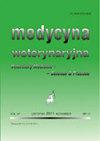马双侧第三掌骨强度参数的pQCT比较
IF 0.4
4区 农林科学
Q4 VETERINARY SCIENCES
Medycyna Weterynaryjna-Veterinary Medicine-Science and Practice
Pub Date : 2022-01-01
DOI:10.21521/mw.6720
引用次数: 0
摘要
第三掌骨(MC3)和近端指骨是运动马最容易受伤的骨头之一。到目前为止,还没有进行详细的分析来比较双侧MC3骨的强度参数,并考虑到不同测量地点的差异。本研究的目的是利用外周定量计算机断层扫描(pQCT)比较马左右MC3骨在10%、20%、30%、40%、50%、60%、70%和80%骨长时的强度参数。研究材料包括21匹马(年龄范围:3-27岁)的分离双侧MC3骨。这些骨头的结构是用高分辨率pQCT测量的。测定以下骨参数:极性强度应变指数、强度应变指数X和强度应变指数y。在骨长10% ~ 80%(每10%)的切片上对MC3骨进行计算机断层扫描分析。统计分析显示,在大多数情况下,pQCT计算的右侧MC3骨在10%、20%和50%的骨长处(即干骺端和干骺端)的强度参数显著较高。然而,在骨干长度的60%和80%处测量的强度参数,即在远端骨干处,左侧MC3骨明显更高。MC3骨参数的进一步研究应集中在干骺端和干骺端附近。本文章由计算机程序翻译,如有差异,请以英文原文为准。
Comparison of the strength parameters of the bilateral third metacarpal bones in horses by pQCT
The third metacarpal (MC3) bone, along with the proximal phalanx, is one of the bones that are most prone to injury in sport horses. To date, no detailed analysis has been conducted that would compare the strength parameters of bilateral MC3 bones taking into account differences depending on the site of measurement. The aim of the study was to compare strength parameters between the left and right MC3 bones in horses at 10%, 20%, 30%, 40%, 50%, 60%, 70% and 80% of the bone length using peripheral quantitative computed tomography (pQCT). The research material comprised isolated bilateral MC3 bones from 21 horses (age range: 3-27 years). The structure of these bones was measured using high-resolution pQCT. The following bone parameters were determined: polar strength strain index, strength strain index X and strength strain index Y. The computed tomographic analysis of the MC3 bones was carried out at sections from 10% to 80% (every 10%) of the bone length. The statistical analysis showed that in most cases the strength parameters calculated using pQCT were significantly higher for the right MC3 bones at 10%, 20% and 50% of the bone length, i.e. at the proximal metaphysis and at the proximal diaphysis. However, strength parameters measured at 60% and 80% of the diaphyseal length, i.e. at the distal diaphysis, were significantly higher for the left MC3 bones. Further studies of the MC3 bones parameters should focus on the vicinity of the proximal metaphysis and at the proximal diaphysis.
求助全文
通过发布文献求助,成功后即可免费获取论文全文。
去求助
来源期刊

Medycyna Weterynaryjna-Veterinary Medicine-Science and Practice
VETERINARY SCIENCES-
CiteScore
0.80
自引率
0.00%
发文量
73
审稿时长
4-8 weeks
期刊介绍:
"Medycyna Weterynaryjna" publishes various types of articles which are grouped in the following editorial categories: reviews, original studies, scientific and professional problems, the history of veterinary medicine, posthumous memoirs, as well as chronicles that briefly relate scientific advances and developments in the veterinary profession and medicine. The most important are the first two categories, which are published with short summaries in English. Moreover, from 2001 the editors of "Medycyna Weterynaryjna", bearing in mind market demands, has also started publishing entire works in English. Since 2008 the periodical has appeared in an electronic version. The following are available in this version: summaries of studies published from 1999 to 2005, full versions of all the studies published in the years 2006-2011 (in pdf files), and full versions of the English studies published in the current year (pdf). Only summaries of the remaining studies from the current year are available. In accordance with the principles accepted by the editors, the full versions of these texts will not be made available until next year.
All articles are evaluated twice by leading Polish scientists and professionals before they are considered for publication. For years now "Medycyna Weterynaryjna" has maintained a high standard thanks to this system. The review articles are actually succinct monographs dealing with specific scientific and professional problems that are based on the most recent findings. Original works have a particular value, since they present research carried out in Polish and international scientific centers.
 求助内容:
求助内容: 应助结果提醒方式:
应助结果提醒方式:


